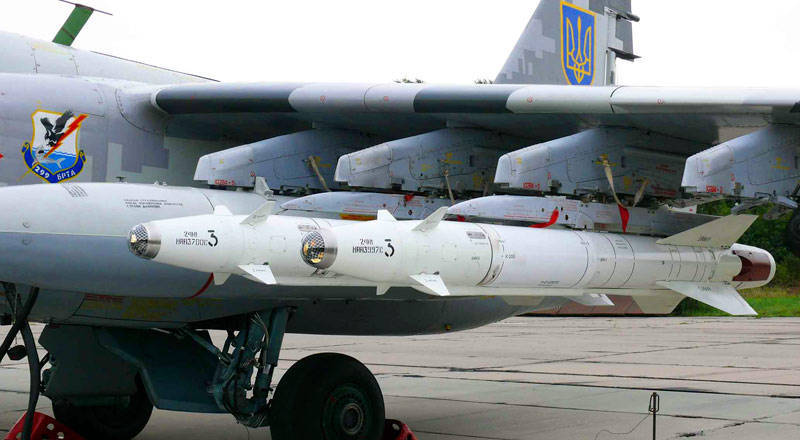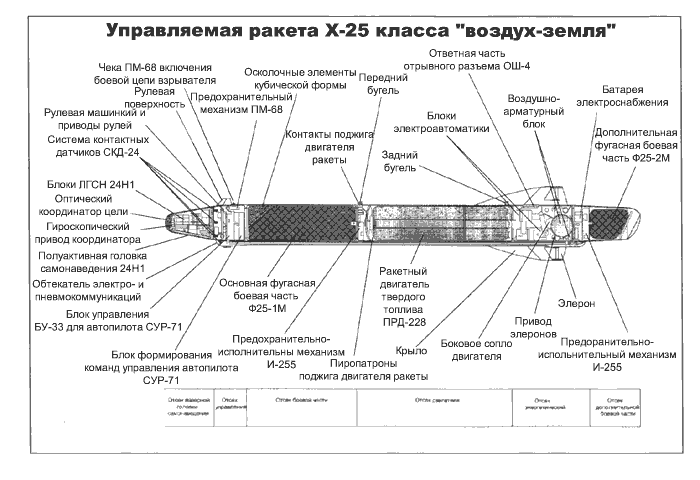Air-to-ground missile X-25 (USSR)

Since the late sixties, Soviet engineers have been working on the development of promising guidance systems for guided missiles. In particular, the development of semi-active laser homing heads was carried out. A similar system was planned to equip the modification of the X-23 rocket called X-23L. However, for certain reasons, this project remained on paper. In the 1970 year, it was decided not to modify the existing ammunition, but a completely new missile, in which, however, it was proposed to use the developments in existing projects.
The head company of the X-25 project or “Product 69” was the OKB “Zvezda”, which already took an active part in the creation of guided aircraft weapons. New development weapons again headed by Yu.N. Korolev. For the creation of a laser seeker, the Geofizika Central Design Bureau was responsible. A new missile was originally proposed to integrate existing and prospective aircraft into the armament complex, which is why from the very beginning, the POO Design Bureau was attracted to the project. Dry. It was assumed that the main carriers of the X-25 product will be exactly the Su brand.
The creation of new components and the development of promising technologies was quite difficult, because of which the development of the project was delayed for several years. Only in the 1973 year was it possible to begin assembling the experimental missiles that were planned to be used in tests. The first test launches showed the need for further improvements of the rocket, as a result of which the work was delayed for several more years.
When developing the “69 Product”, the specialists of “Zvezda” decided to use layout solutions and some units borrowed from the X-66 and X-23 projects. A similar approach to the design promised some simplification of the mass production of new products, since the manufacture of some components for existing missiles was already established.
Product X-25 received an updated cylindrical body with a conical head and tail fairing. Case length - 3,75 m, maximum diameter - 275 mm. In the forward part of the hull, the X-shaped rudders are preserved, in the tail part, the wing has a span of 850 mm. The layout of the internal volume of the body was borrowed from previous projects, but has undergone great changes. Inside the head fairing with a transparent cap placed the equipment of the semi-active laser seeker. Behind the head compartment were the steering cars and part of the electrical equipment. The middle part of the rocket was occupied by a high-explosive fragmentation warhead, behind which a solid-propellant rocket engine with two nozzles was placed on the side surface of the body. Next to the wings was another compartment for automation. The control systems of the previous missiles were located in the tail section of the hull. The change in the layout associated with the new GOS resulted in the release of the tail fairing and a change in balancing. To compensate for the loss of weight in the tail of the rocket X-25 placed a relatively small additional warhead.
Due to the use of new components, the X-25 rocket was noticeably heavier compared to its predecessors. Her starting weight reached 320 kg.
For the X-25 rocket, a new solid propellant engine PRD-228 was created with two nozzles placed on the side surface of the hull. Such a power plant had to accelerate the rocket to a speed of about 800-850 m / s. The flight range to 10 km was provided.
To hit a target, the 69 rocket was supposed to carry two combat units at once. In the middle part of the case there was a ФХNUMX-25М unit with a total weight of 1 kg with an 112-kilogram explosive charge. Around the charge located ready-made damaging elements. In the tail section of the rocket, it was proposed to install an additional warhead of the FNNXX-80M, which had a mass of 25 kg and a charge of 2 kg. The second combat unit was designed to solve two problems at once: it increased the power of the ammunition, and also provided the required balancing.
Especially for the new guided missile, the Geophysics Central Design Bureau developed the semi-active laser homing head 24H1. This product was built according to the scheme, which is now considered a classic for such equipment. A fixed photodetector, a moving coordinator (focusing system), as well as a signal processing unit and control commands were included in the GSN. A laser beam aimed at the target was to be used to guide the missile. The task of the laser seeker was to search for the spot of reflected light and develop commands for the steering gears.
Initially it was assumed that target designation will be carried out by special equipment of the aircraft carrier. To equip existing and future aircraft, a container of laser equipment “Searchlight-1” was developed. It could be used with aircraft of various types. For example, during the first tests, the carriers of the missiles and the container were Su-7BM and Su-17М fighters.
The main work on the X-25 project was completed at the beginning of 1973. In the winter of the same year, the first launches were carried out from Su-7BM and Su-17M aircraft. During the first test phase, 36 test flights were conducted with 12 rocket launches. In one of the launches, two missiles were dropped from the plane at once. The first checks showed the viability of the proposed ideas, and also allowed to identify existing problems. Designers had to refine the project.
One of the claims related to used aircraft carriers. In this regard, further tests were carried out with the use of Su-17М2 fighter-bomber, which were equipped with newer and more advanced aiming equipment. According to some data, the Su-1974М17 aircraft was used in the state tests of 2, which was modernized and received the new designation Su-17MKG ("Upgraded with a quantum generator"). The carrier aircraft performed 69 flights with 30 rocket launches. In the same 74, an aviation strike complex was tested on the basis of the MiG-23BK (MiG-27K) aircraft, equipped with the Kaira aiming system.
In 1974, the USSR Air Force adopted a new missile system as part of the X-25 air-to-surface missile and the Searchlight-1 container system with the Fon laser rangefinder. The container allowed to deflect the laser beam in a vertical plane, so that the launch of the rocket could be carried out not only in a dive, but also in horizontal flight. The capabilities of the Projector-1 system allowed launching at speeds of 730-1000 km / h at altitudes of 500-4000 m. The allowable launch range was within 3-7 km.
With the help of the “Searchlight-1” system, it was possible to hit targets with a circular deviation of 6,4 m. For this, the pilot had to maintain the aircraft course for some time and keep the aiming mark on the selected target. Since the laser beam could only move in a vertical plane, this method of using the X-25 guided missile resembled the X-66 and X-23 methods. To reliably hit a target, the pilot was required to hold the target in sight for approximately 10 seconds.
Soon the X-25 rocket was “taught” to work with other targeting devices. The Su-17М3, Su-17М4, Su-25 and MiG-27М aircraft used laser rangefinders, target indicators of the "Maple" family. These systems included mechanisms that allowed the laser beam to be deflected within a sector of width 24 ° in the horizontal plane and from + 6 ° to -30 ° in the vertical. The highest effectiveness of hitting a target using the Klen system was achieved during a dive launch. However, the pilot had the opportunity to attack in horizontal flight, as well as to do some small maneuvers.
The most advanced target designator for the X-25 rocket was the Kaira laser-television system, which was installed on MiG-27K and Su-24М aircraft. When using it, the search for the target was made using a video system with the possibility of enlarging the image. The guidance was carried out in a semi-automatic mode: the pilot was required to hold the target in the sight, and the automatic equipment independently directed a laser beam at it. Under certain conditions, the Kaira system allowed attacking targets not only in the front, but also in the lower hemisphere, literally under the plane. For this, the opto-electronic unit with a laser could “collapse” in a vertical plane at an angle of more than –90 °.

Since the late seventies, Soviet engineers have been working on the further development of the X-25 guided missile. Over the course of several years, a number of new modifications of this weapon were created, differing from the base product by the characteristics, components used, etc. In addition, the unification of new products for various components was laid. The list of rocket modifications that appeared since the beginning of the eighties looks as follows:
- X-25MA. Version of the rocket with an active radar homing head. The new hardware unit was designed as a separate module that is installed instead of the base head fairing. Such improvements have led to an increase in the length of the rocket to 4,3 m. Other characteristics remained at the same level. Since the late nineties, it has been offered to foreign customers;
- X-25ML. From the base of the rocket differs set of used components. In addition, a new control system was used to keep the rocket on track. Product characteristics generally remained the same;
- X-25MP. To destroy the enemy's radar, a missile with a passive radar seeker was developed. The X-25MP missiles were equipped with two types of GOS: PRGS-1VP and PRGS-2VP, designed to attack various types of targets. As in the case of the X-25MA, the new guidance systems were designed as separate head modules and therefore increased the length of the rocket;
- X-25MPU. An improved version of the anti-radar missile with an updated homing system capable of detecting foreign radars of new types. In addition, the rocket had an inertial navigation system that allowed it to continue flying and to re-search for a target pickup after the failure of the attack;
- X-25МР. To a certain extent, a simplified version of the basic X-25 with a radio command control system. In the tail section of the hull there was a tracer for tracking the movement of the rocket. Control was carried out from the aircraft carrier;
- X-25MT. Modification with a television guidance system. Due to some improvements it is capable of hitting targets at ranges up to 20 km. Television seeker, as in other cases, was carried out in the form of a special head module;
- X-25MTP. Option with thermal imaging seeker. According to its characteristics it corresponds to other missiles of the family, however, it can be used according to the “launched-forgotten” principle.
The X-25 rocket was used during the conflicts in Afghanistan and Chechnya to destroy various enemy targets. For targeting, both the aircraft carrier equipment and ground equipment were used. Semi-active laser guidance provided acceptable accuracy of hits. In combination with the relatively high power of the warhead, the new GOS allowed destroying enemy targets with a minimum expenditure of ammunition. The X-25 missile proved to be more convenient and effective than the older X-66 and X-23 with radio control.
For several years of production, at least 20-22 thousand X-25 missiles of all modifications were assembled. This weapon is still in service with the air forces of Russia. With the advent of the new guided missiles, the X-25 gives up its place to them, but so far remains in the arsenals.
On the materials of the sites:
http://airwar.ru/
http://rbase.new-factoria.ru/
http://aviaros.narod.ru/
http://vadimvswar.narod.ru/

Information